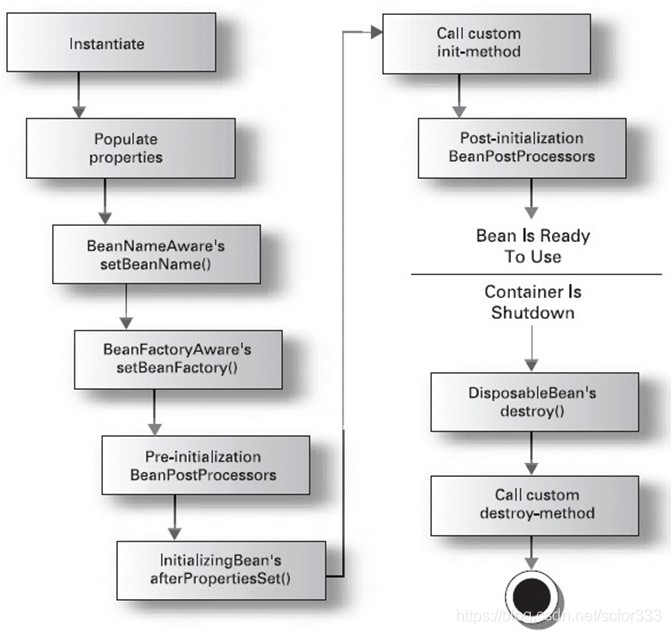Spring 中 bean 的生命周期
bean 生命周期
bean 的生命周期大致流程如下,后面会为大家解释每个流程具体的作用

- instantiate bean 对象实例化
- populate properties 封装属性
- 如果Bean实现 BeanNameAware 执行 setBeanName
- 如果 Bean 实现 BeanFactoryAware 执行 setBeanFactory,获取 Spring 容器
- 如果存在类实现 BeanPostProcessor(后处理Bean),执行 postProcessBeforeInitialization
- 如果 Bean 实现 InitializingBean 执行 afterPropertiesSet
- 调用
<bean init-method="init">指定初始化方法 init - 如果存在类实现 BeanPostProcessor(处理Bean),执行 postProcessAfterInitialization
- 如果 Bean 实现 DisposableBean 执行 destroy
- 调用
<bean destroy-method="customerDestroy">指定销毁方法 customerDestroy
对象实例化
bean 的生命周期从对象的实例化开始,当运行到下面的代码时,就会实例化beans5.xml中bean标签所定义的对象,并执行其构造方法
ApplicationContext context = new ClassPathXmlApplicationContext("beans5.xml");
封装属性
接下来,Spring 会根据bean标签下的property标签来为对象赋值,即依赖注入(封装属性),这时实际执行的是实现类中对应属性的set方法,也就是说,想要通过这个方式为对象封装属性,实现类中必须含有对应属性的set方法
private String name;
private String password;
public String getName() {
return name;
}
public void setName(String name) {
this.name = name;
System.out.println("set name");
}
public String getPassword() {
return password;
}
public void setPassword(String password) {
this.password = password;
System.out.println("set password");
}
<bean id="user" class="com.lmh.model.User" init-method="myInit" destroy-method="myDestroy">
<property name="name" value="lmh"></property>
<property name="password" value="123"></property>
</bean>
BeanNameAware
如果实现类中实现了BeanNameAware接口,那么接下来对象就会执行重写的setBeanName方法
@Override
public void setBeanName(String s) {
// s:bean.xml 中的 bean id
System.out.println("set Bean name: " + s);
}
通过输出我们知道,setBeanName函数的参数s为bean标签中的id属性的值
BeanFactoryAware
如果实现类中实现了BeanFactoryAware接口,接下来对象会执行重写的setBeanFactory方法
@Override
public void setBeanFactory(BeanFactory beanFactory) throws BeansException {
// 工厂生产对象后放进容器中去
System.out.println("Bean Factory: " + beanFactory);
}
此时是 Bean 工厂生产的对象被放进 Spring 容器中的过程
BeanPostProcessor
BeanPostProcessor是 Spring IOC 容器提供的一种处理器接口,可以理解成一种对所有beans.xml中对象均有效的处理器
使用时我们需要自定义处理器类,实现BeanPostProcessor接口,重写其postProcessBeforeInitialization和postProcessAfterInitialization方法
import org.springframework.beans.BeansException;
import org.springframework.beans.factory.config.BeanPostProcessor;
public class MyBeanProcessor implements BeanPostProcessor {
// 对所有对象有效
@Override
public Object postProcessBeforeInitialization(Object o, String s) throws BeansException {
// 可用于多个对象的共同事情
System.out.println("Before: " + s + " : " + o);
return o;
}
@Override
public Object postProcessAfterInitialization(Object o, String s) throws BeansException {
System.out.println("After: " + s + " : " + o);
return o;
}
}
其中o为当前执行处理器的对象,s为 bean 的id 属性值,这里postProcessBeforeInitialization方法在 bean 的生命周期中会在上一步后执行,而postProcessAfterInitialization图中 Bean Is Ready To Use 之前执行
InitializingBean
如果实现类中实现了InitializingBean接口,对象接下来会调用重写的afterPropertiesSet方法
@Override
public void afterPropertiesSet() throws Exception {
System.out.println("6.Pro is seted...");
}
自定义 Init 方法
随后,如果我们在实现类中自定义了 Init 方法,再bean标签中设置了init-method="init"属性后,自定义的 Init 方法会在这时执行
public void myInit() {
System.out.println("7.My Init");
}
<bean id="user" class="com.lmh.model.User" init-method="myInit">
</bean>
DisposableBean
以上周期执行完毕后,bean 就进入了可以被使用的状态,当 bean 使用结束后,需要销毁对象时,如果实现类中实现了DisposableBean接口,会执行从写的destroy方法
@Override
public void destroy() throws Exception {
System.out.println("9.Bean is Destroy");
}
自定义 Destroy 方法
如果自定义了 Destroy 方法,会在这是执行,方式和自定义 Init 方法一致,实现类中定义 Destroy 方法,并在bean标签中设置destroy-method="destroy"属性
public void myDestroy() {
System.out.println("my Destroy");
}
<bean id="user" class="com.lmh.model.User" destroy-method="myDestroy">
</bean>
